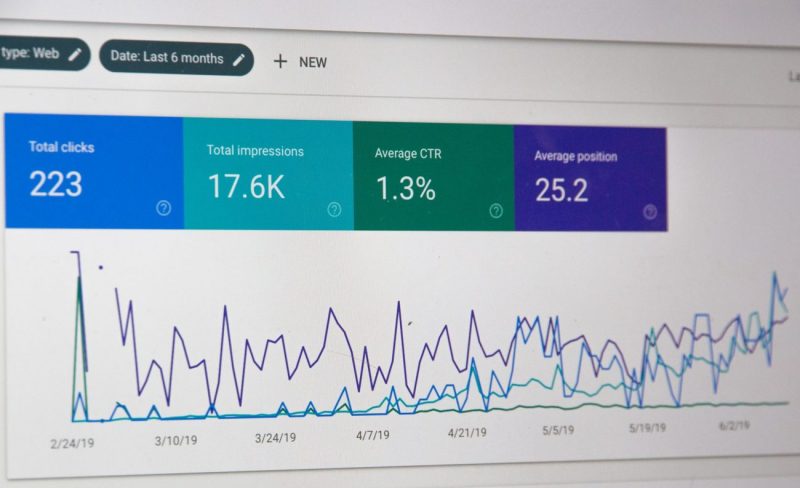What are the metrics and KPIs?
You have probably heard about metrics and how they can help you improve your business. ¿But what are metrics? They are numerical data that you can analyze to check whether your marketing actions are properly functioning.
These metrics will help us to know the right way to improve, attract quality traffic, increase your visibility in search engines or capture potential customers. Other elements that will help us improve will be the KPIs (Key Performance Indicator), that help us understand the effectiveness and performance of the strategy.
The main difference between KPI and metrics is the function. KPIs allow us to know the performance of actions in a given time. In contrast, metrics are not indicators, but are data derived from the strategy created by the company.
In short, metrics are not KPIs, as these are quantifiable data that help us to know the results of effectiveness and performance. KPIs are metrics that are generated by SEO actions.

For a better understanding, here is an example. The metrics focus on the quantum and KPIs on the ratios of these metrics. The metric would be the number of views to your website and the KPI would be the web traffic that encompasses the performance of said website, the web pages viewed or the bounce rate.
A good KPI helps us know the following elements:
- Data about the progress and it helps us make decisions based on said information.
- Monitoring essential elements such as the quality, effectiveness, efficiency or the performance of duties.
- Enables to know the long term performance.
- Information about the development of the objectives set.
¿How many KPIs do we have to choose?
The number of KPIs will directly depend on the objectives that your company has. Through a single metric you will not be able to know the performance of your entire business. Therefore, it is important that you are clear about the objectives to be achieved, and with them determine the KPIs necessary to carry out an analysis of these and obtain the necessary information to continue growing.
The essential aspect when selecting the KPIs is to know your objectives. Once you have determined the goals to be achieved, you must join them to three KPIs at most, since you will not be able to cover all the existing metrics. In this way, you will select the most important metrics that will help you achieve your goals.
SMART objectives
Once we have set our objectives, we must check whether these can actually be implemented. For this purpose, we have the SMART objectives. Thanks to these techniques we can verify if our goals can be set in motion or not.

Specific
How are we going to achieve the objective? In order to grow, we must create specific objectives based on data, for example, an increase of 25 % of customers in one year. We cannot focus an objective based on growth without data or time
Measurable
How are you going to measure it? In order to set objectives, they must be measurable, i.e. it must be possible to quantify them with numbers.
Achievable
What is the key action to be achieved? The objective must be feasible and realistic. We cannot set too high a goal, because it will be impossible to achieve.
Relevant
Will it help us achieve the overall company objectives? We must the global objectives in mind when setting specific objectives, which will lead to further growth in the company.
Timely
Is it possible to achieve the goal on time? The last requirement to create a goal is that it is fixed in time. We cannot create objectives without a timeline, as they will not be carried out.
Metrics
Google Analytics will allow you to get to know specific information about your company. You will be able to analyse it and see the issues that emerge, what actions function correctly and what elements to improve. To define the objectives, as previously mentioned, you must take into account the metrics and KPIs to measure the information and thus, keep growing. Here are some of the metrics that can help you set goals for your company:
- Number of views on your website
How many times have users visited your website? We must make a differentiation between numbers of viewers and the viewed pages
- Percentage of viewers
In this metric, it is important that you take into account the recurring viewers and the new ones. It is better to have a bigger number of recurring visitors than new ones, because if they visit your website, it is because the content or the products/services that they offer are good.
- Time spent
How long do your users stay on your website? By knowing the user’ routes, you will be able to keep track of which pages are working and which are not.
- Bounce rate
The percentage of users that abandon your website directly, without interacting with it.
- Audience per area
Thanks to this metric, you will get to know the origin of your audience, so that you can target them according to different interests.
- Audience by age and gender
Like the previous metric, this will allow you to get to know your audience in depth in order to meet their needs.
- Interests and affinities of your audience
If you know your audience, you will have more chances of keeping them. Therefore, it is important to keep up to date with their needs and interests.
- Visits by devices
By keeping up to date with the devices used by your customers you will be able to focus on one or the other. Furthermore, it is important to take into account this metric for the user’ experience, as more and more people are checking information from their mobile phones.
- Conversion rates of visits
How many of the views your website gets turn into customers? That is one of the most important metrics, because it helps to know the element that engages your audience.
- Conversion funnel
If you are up to date with the journey of your customer, you will know the phase where you fail, where you win and the one you need to improve. Not only that, but you will also be able to keep track of the stages they are in and the time it takes to become a customer.
- Comments, opinions and recommendations
The percentage of the comments and opinions, whether they are positive or negative. This will enable you to keep improving and know the perspectives of your customers.
- Source of the views
What is the main source of your views? SEO, SEM, social media…? If you have knowledge about the origin, you can opt for a strategy or another.
- Campaign performance
Do your campaigns function correctly? This system can be measured through Google Adwords, since they will provide you the necessary information to know if your campaign is working or not.
- Return of investment
Do your campaigns generate financial benefits? With the creation of campaigns, our objective is to grow both personally and financially. With this metric you will be able to know which campaigns are more profitable than others, be able to draw conclusions and thus focus your strategy in one way or another.
- Conversions per channel
How many conversions are made per channel? This metric will help you to know the channel through which users convert into customers. In other words, the one you should focus on in order to continue growing.





